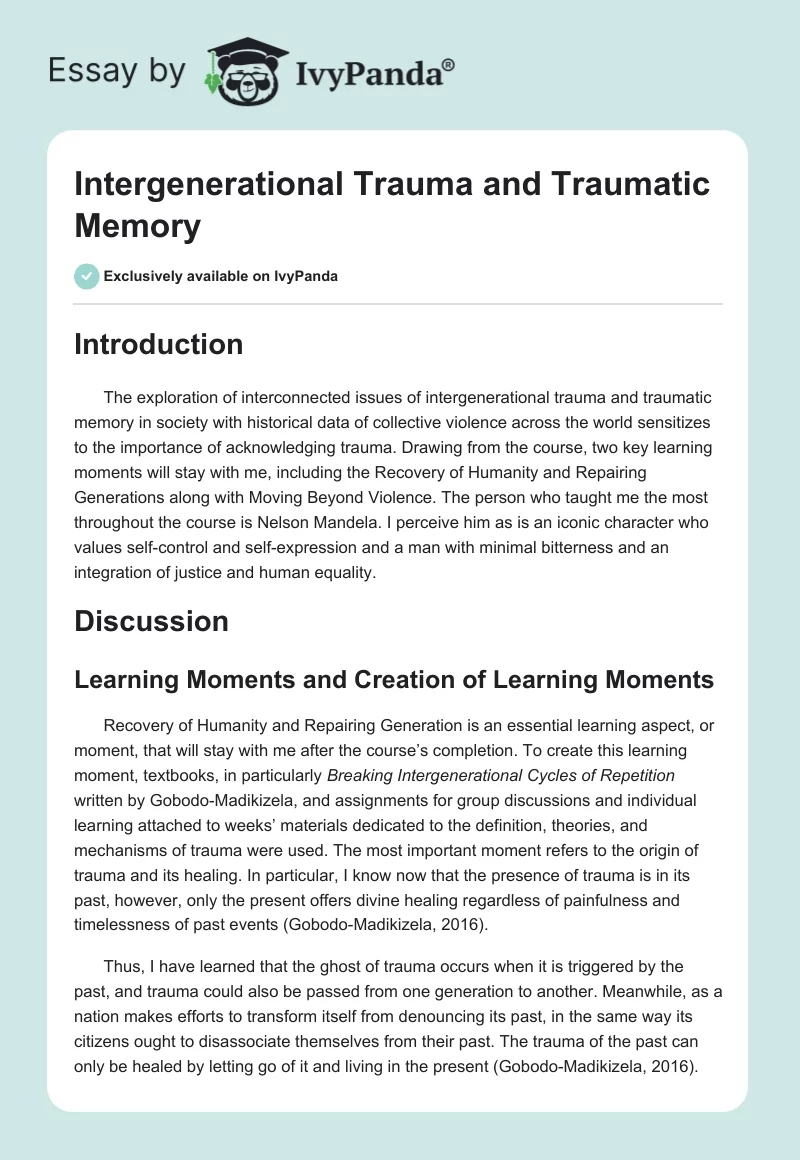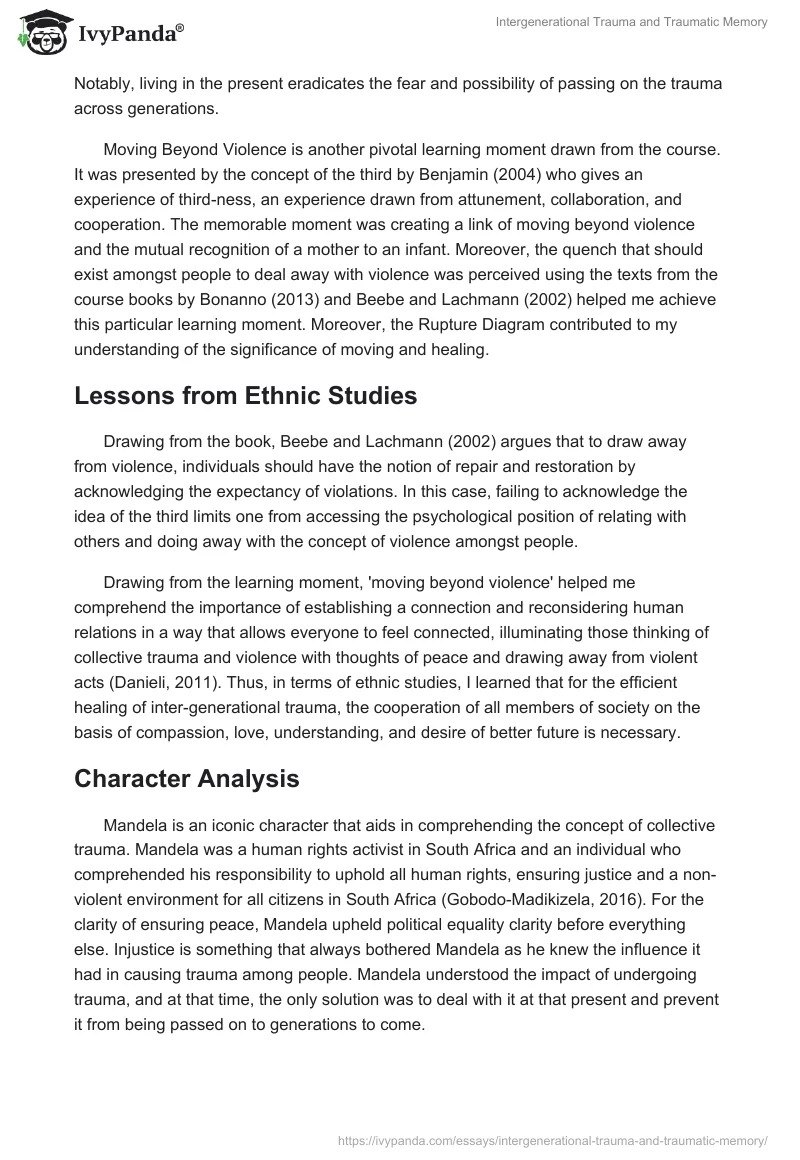Introduction
The exploration of interconnected issues of intergenerational trauma and traumatic memory in society with historical data of collective violence across the world sensitizes to the importance of acknowledging trauma. Drawing from the course, two key learning moments will stay with me, including the Recovery of Humanity and Repairing Generations along with Moving Beyond Violence. The person who taught me the most throughout the course is Nelson Mandela. I perceive him as is an iconic character who values self-control and self-expression and a man with minimal bitterness and an integration of justice and human equality.
Discussion
Learning Moments and Creation of Learning Moments
Recovery of Humanity and Repairing Generation is an essential learning aspect, or moment, that will stay with me after the course’s completion. To create this learning moment, textbooks, in particularly Breaking Intergenerational Cycles of Repetition written by Gobodo-Madikizela, and assignments for group discussions and individual learning attached to weeks’ materials dedicated to the definition, theories, and mechanisms of trauma were used. The most important moment refers to the origin of trauma and its healing. In particular, I know now that the presence of trauma is in its past, however, only the present offers divine healing regardless of painfulness and timelessness of past events (Gobodo-Madikizela, 2016).
Thus, I have learned that the ghost of trauma occurs when it is triggered by the past, and trauma could also be passed from one generation to another. Meanwhile, as a nation makes efforts to transform itself from denouncing its past, in the same way its citizens ought to disassociate themselves from their past. The trauma of the past can only be healed by letting go of it and living in the present (Gobodo-Madikizela, 2016). Notably, living in the present eradicates the fear and possibility of passing on the trauma across generations.
Moving Beyond Violence is another pivotal learning moment drawn from the course. It was presented by the concept of the third by Benjamin (2004) who gives an experience of third-ness, an experience drawn from attunement, collaboration, and cooperation. The memorable moment was creating a link of moving beyond violence and the mutual recognition of a mother to an infant. Moreover, the quench that should exist amongst people to deal away with violence was perceived using the texts from the course books by Bonanno (2013) and Beebe and Lachmann (2002) helped me achieve this particular learning moment. Moreover, the Rupture Diagram contributed to my understanding of the significance of moving and healing.
Lessons from Ethnic Studies
Drawing from the book, Beebe and Lachmann (2002) argues that to draw away from violence, individuals should have the notion of repair and restoration by acknowledging the expectancy of violations. In this case, failing to acknowledge the idea of the third limits one from accessing the psychological position of relating with others and doing away with the concept of violence amongst people.
Drawing from the learning moment, ‘moving beyond violence’ helped me comprehend the importance of establishing a connection and reconsidering human relations in a way that allows everyone to feel connected, illuminating those thinking of collective trauma and violence with thoughts of peace and drawing away from violent acts (Danieli, 2011). Thus, in terms of ethnic studies, I learned that for the efficient healing of inter-generational trauma, the cooperation of all members of society on the basis of compassion, love, understanding, and desire of better future is necessary.
Character Analysis
Mandela is an iconic character that aids in comprehending the concept of collective trauma. Mandela was a human rights activist in South Africa and an individual who comprehended his responsibility to uphold all human rights, ensuring justice and a non-violent environment for all citizens in South Africa (Gobodo-Madikizela, 2016). For the clarity of ensuring peace, Mandela upheld political equality clarity before everything else. Injustice is something that always bothered Mandela as he knew the influence it had in causing trauma among people. Mandela understood the impact of undergoing trauma, and at that time, the only solution was to deal with it at that present and prevent it from being passed on to generations to come.
From Mandela, I learned that ‘sorry’ is a term that is essential in trauma recovery. ‘Sorry’ as a word is enough to create an interruption of cycles of violence in the current and next generations (Updegraff et al., 2008). Mandela shows that standing for your rights is essential, however, associated trauma should not limit future opportunities. Thus, regardless of the painfulness of the past, it is highly essential to accept it, excuse for mistakes, and continue moving forward.
Helpful Studies in Future
Course topics, including “Confronting the past, engaging the other in the present” and” Breaking cycles of trauma,” are two significant topics that will continue to enlighten me further on recovering from trauma. They expound on the impacts of violence in various countries of Africa, such as Nigeria, Arusha, Burundi, and others, and emphasize the importance of ensuring peace and advocating for truthfulness and forgiveness among citizens (Gobodo-Madikizela, 2016). Finally, they support the idea that reconciliation is also important in combating violence and trauma’s healing.
Conclusion
In conclusion, I have learned the importance of intense focus on trauma, the traumatic events, places of trauma, as well as the aftermath of trauma (Blodgett & Yakushko, 2017). Drawing from the course, I have also gained significant knowledge from topics such as multidirectional memory. Multidirectional memory refers to a memory that compares experiences and their associated aftermaths encountered by different groups. Having such a memory enables one to expound on the concept of trauma and the process of trauma recovery. In conclusion, I must admit that the course has been insightful and essential in creating awareness of the complexities of traumas.
References
Beebe, B., & Lachmann, F. M. (2002). Infant research and adult treatment: Co-constructing interactions. Routledge.
Benjamin, J. (2004). Beyond doer and done to: An intersubjective view of thirdness. The Psychoanalytic Quarterly, 73(1), 5-46.
Blodgett, E., & Yakushko, O. (2017). Existential angst and meaning-making in narratives of Lithuanian survivors of Soviet political deportations. Journal of Humanistic Psychology, 60(3), 342–364. Web.
Bonanno, G. A. (2013). Meaning-making, adversity, and regulatory flexibility. Memory, 21(1), 150–156. Web.
Danieli, Y. (2011). International handbook of multigenerational legacies of trauma. Springer.
Gobodo-Madikizela, P. (2016). Breaking intergenerational cycles of repetition a global dialogue on historical trauma and memory. Barbara Budrich Publishers.
Updegraff, J. A., Silver, R. C., & Holman, E. A. (2008). Searching for and finding meaning in collective trauma: Results from a national longitudinal study of the 9/11 terrorist attacks. Journal of Personality and Social Psychology, 95(3), 709–722. Web.


